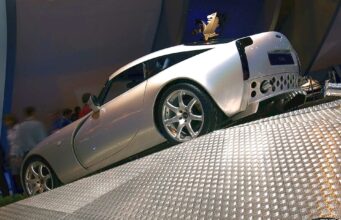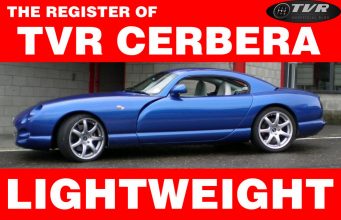
Typically of TVR owners, the factory was under increasing pressure to produce higher performance models. The familiar route was to install a bigger engine, once again reverting to the trusty Rover V8 displacing 4 litres. Launched in 1991, the TVR V8S had a healthy 240 bhp and torque was around 270 lb/ft. The 0 to 60 mph dash could now be achieved in under 5 seconds, awesome performance for the price. Mid range acceleration was enough to embarrass many a supercar.
In order to cope with the increased power, the gearbox was from the Rover SD1, the rear drums were replaced with discs and a limited slip differential was installed. After a short time, the chassis was strengthened to reduce flexing. In total, over 400 of the V8S were produced from 1991 through to 1994.
Two variants of the V8S exist. The last few models produced used a Chimaera specification engine. This had the same power output as the earlier models, but with different characteristics. More torque was available at lower revs, and the rev limit was lower at about 5600 rpm. The last TVR V8S’s made in 1993 were registered as TVR V8SC’s. These were the Chimaera spec models fitted with catalysts. It’s thought that approximately 25 of these models exist.
TVR V8S 2 litres
this was created for the Italian market to overcome their strict taxation based on engine capacity. The engine was a modified 3.5 litre Rover V8 fitted with a smaller-throw crank to reduce the engine capacity, retaining the 88.9 mm bore but with an extremely short stroke of 40.25 mm. This meant a displacement of 1,998 cc (2.0 L), with a compression rate of 8.0:1. Lucas electronic fuel injection was fitted, along with an intercooled Eaton supercharger. All of this produced 233 PS (171 kW; 230 bhp) at 6,200 rpm and 266 N·m (196 lb·ft) at 3,700 rpm. Performance was on par with the bigger V8s, with a top speed of 232 km/h (144 mph) and 0-100 km/h coming up in 6.5 seconds. Ventilated disc brakes were fitted up front, and the 2-litre V8 also got adjustable ride height hydraulic shocks. A large hump was required in the bonnet to house the supercharger. This bonnet was later used on the V8S






















Nice info, I did forget about the
V8SC.
and did never heart about that Italian downsized 2.0…
its a shame that they did that just because of "benefits" and made it 2.0…
GTRene